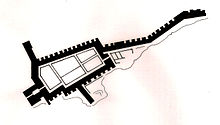Shalfak
| Shalfak in hieroglyphs | ||||||
|---|---|---|---|---|---|---|
Waf-Chastiu Wʾf-ḫ3s.wt | ||||||

Shalfak (originally Waf-Chastiu, "subduing the foreign lands")
The fortress occupies a roughly triangular area of about 1800 m2, adapted to the available ground. Its massive mudbrick wall still stands up to 6 metres high and 8 meters thick. Three spur walls, towards the north, west and east, complete the fortification system. The eastern wall protects a stairway leading down to the river to ensure access to a water supply in the case of siege.[3] The internal structures are very well preserved including a command building, barracks, workshops, storerooms and a granary arranged in a grid plan.[4]
Excavations were conducted in February and March 1931 by a team of the
References
- ISBN 978-0-679-60429-7.
- ^ "Shalfak | Discover Sudan! Archaeological and Cultural Tours". discoversudan.de. Retrieved 2017-11-21.
- ISBN 0-203-98283-5, pp.747-753.
- ISBN 0-203-98283-5, pp. 1083-1084.
- ^ Claudia Näser: Shalfak: a Middle Kingdom fortress in Lake Nubia, in Egyptian Archaeology 52, Spring 2018, pp. 4-9
21°32′30″N 31°2′25″E / 21.54167°N 31.04028°E
